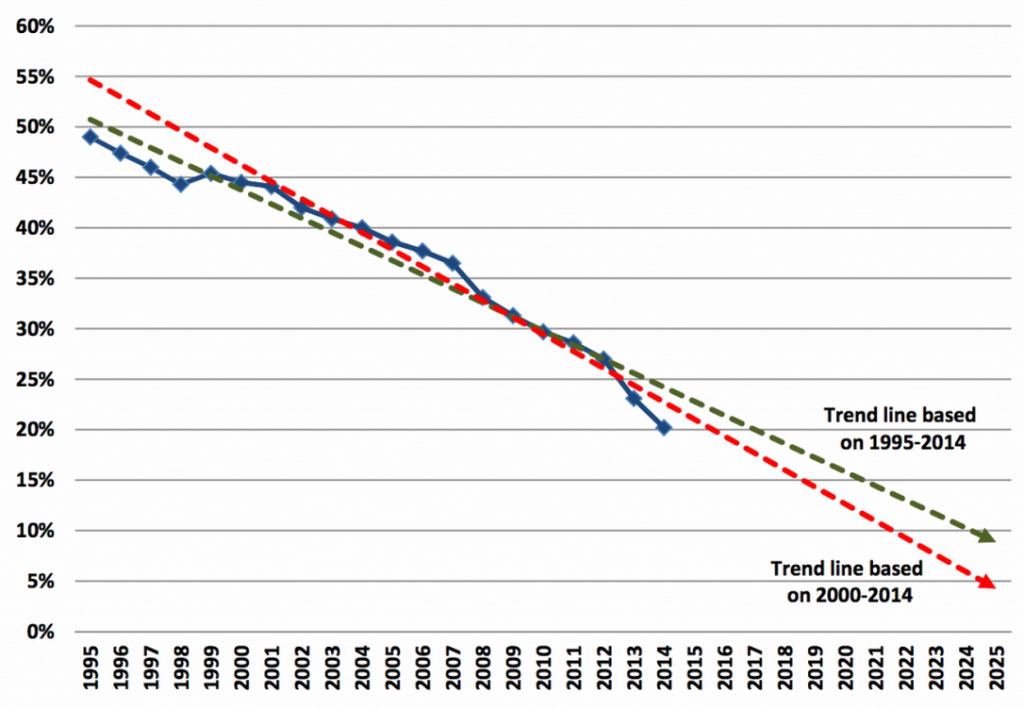Ken Goldstein, a leading media business analyst in Canada, has just published a grim prediction for legacy news outlets north of the border: “In 2025, it is likely that there will be few, if any, printed daily newspapers.”
For good measure, Goldstein adds, “there might be no local broadcast stations in Canada” 10 years from now.
 While noting declines in advertising, classified particularly, Goldstein bases his bleak view on newspaper circulation trends (see graph). Daily paid circulation as a percentage of Canadian households, he writes, has fallen from just under 50 percent in 1995 to 20 percent in 2014.
While noting declines in advertising, classified particularly, Goldstein bases his bleak view on newspaper circulation trends (see graph). Daily paid circulation as a percentage of Canadian households, he writes, has fallen from just under 50 percent in 1995 to 20 percent in 2014.
If those declines continue, circulation will amount to only 5 to 10 percent of households in 2025, too little, Goldstein says, “to support a viable print business model for most general interest daily newspapers.”
He adds in his August 20 paper, “Canada’s Digital Divides,”
Thus, Canada’s daily newspapers now are engaged in a 10-year race against time and technology to develop an online business model that will enable them to preserve their brands without print editions, and – even more difficult – to try to develop new kinds of economic bundles (or other kinds of economic arrangements) that will enable their online presence to maintain their current journalistic scope.
Goldstein has elsewhere described Canada as a big country but a smallish media market. Lack of scale, a split of readers by language, and a predominance of national papers over local all conspire to make the country’s newspapers especially vulnerable to disruption.
While U.S. newspaper finances are hardly robust, they still boast both daily and Sunday circulation above 40 million, penetrating daily to about a third of households.
For television. Goldstein sees the local broadcast sector failing to adapt as the traditional over-the-air model gave way to cable and now Internet delivery. In the U.S. huge political advertising revenue windfalls and retransmission fees continue to keep local stations highly successful financially. Canada lacks those factors, and Goldstein says the stations have become “a much less profitable business — and now (find themselves) in a money-losing situation.”
Goldstein also consider the impact on journalism as newspapers and local broadcast fade:
If the two largest sources of spending on journalism in Canada today might be gone or much diminished in 2025, what will take their place? A small number of traditional media might be able to make the transition to become national or international online news “brands”, but what will happen to local journalism?
Will we get our news from Apple, Google, or Facebook? Without the current scope of journalistic output, where will Apple, Google and Facebook get their news? And, of course, there are numerous online-only start-ups, often specialized in nature, but few, if any, provide the kind of journalistic scope of our current local daily newspapers or local broadcast television.
He also worries that it is uncertain whether newer journalism outlets will embrace standards of fact-checking, emphasis and other sound practices embedded in the legacy outlets.
I’m not close enough to the Canadian scene to say whether Goldstein’s take is on target or alarmist. But he has been analyzing that nation’s media for several decades, and both his numbers and reasoning are persuasive.
I have also observed that Canadian newspapers have been making bold and urgent plays in digital suggesting that they see a more measured approach as a losing end game. The Toronto Star implemented a paywall, then took it down this April, promising to continue investments in video and other digital enhancements.
La Presse, a Montreal Daily, has made a huge bet over the last several years in a high-quality, bells-and-whistles tablet version, and executives have said that La Presse may soon discontinue its print edition altogether.
The Winnipeg Free Press launched an experiment with micro-payments in April, pricing individual articles at 27 cents (21 cents U.S.).
Goldstein writes that in Canada, public spending has been focused on a government-financed television service and building broadband access. Perhaps it is time, he concludes, that support of journalism “should also have high priority as a parallel concern of public and private policy.”







